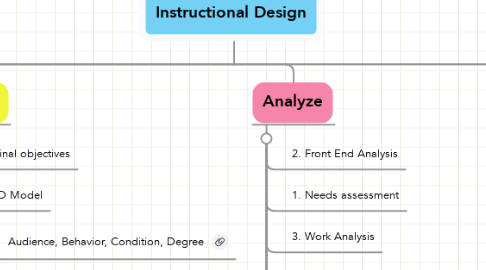
1. Analyze
1.1. 2. Front End Analysis
1.2. 1. Needs assessment
1.3. 3. Work Analysis
1.4. 4. Content/Task Analysis
1.4.1. What do you already know? (know)
1.4.2. What do you need to research? (research)
1.4.3. What is the sequence going to be? (sequence)
1.4.3.1. Course map
1.5. 5. Context Anaylsis (info here also refers to Resource Analysis)
1.5.1. Funding & policies
1.5.2. Demographics
1.5.3. Technology
1.5.4. Materials
1.5.5. School culture
1.5.6. Other teacher/staff expertise
1.6. 6. Cognitive Analysis
1.7. 7. Resource Analysis
1.8. 8. Learner Analysis
1.8.1. accommodations
1.8.2. ELLs
1.8.3. actual grade level (per subject)
1.8.4. previous knowledge and skills
1.8.5. strengths & weaknesses
1.8.6. home life/personal issues
1.8.7. style--personality, learner style
1.9. 9. Affective Analysis
2. Design
2.1. Terminal objectives
2.2. ABCD Model
2.2.1. Audience, Behavior, Condition, Degree
2.3. Enabling objectives
2.4. Domains:
2.4.1. Cognitive
2.4.1.1. Bloom's Taxonomy
2.4.2. Affective
2.4.3. Psychomotor
2.5. Maryland State standards
3. Development
3.1. Creating Lesson Plans
3.1.1. Funds of Knowledge should be considered!
3.2. Gagne's 9 Events of Instruction
4. Evaluation
4.1. Formative Assessments
4.2. Summative Assessments
4.3. Scoring Rubrics
4.4. Evaluation Plan: Objectives, activities, formative & summative assessments all tie in together
5. Understand by Design (UbD)
5.1. Essential Questions
5.1.1. How does inquiry affect knowledge?
5.1.2. Conceptual based questions
5.1.3. Not answered easily
5.1.4. Experience, explore, evaluate
5.1.5. Supporting questions
5.2. Enduring Understandings
5.2.1. big ideas or important understandings
5.2.2. Larger purpose: Why is this topic worth studying?
5.2.3. Two concepts and one verb
6. Understanding Design for Learning (UDL)
6.1. Assistive technology
6.2. Guidelines
6.3. Differentiation (very similar to UDL but targets for sutdents with special needs
6.3.1. Content
6.3.2. Process
6.3.3. Product

